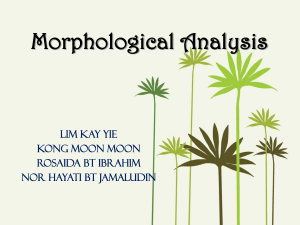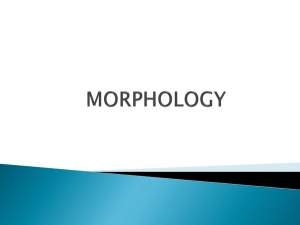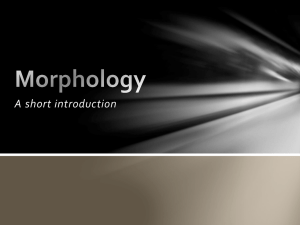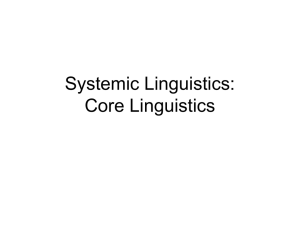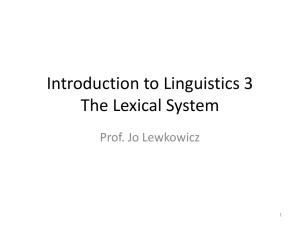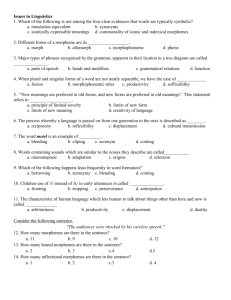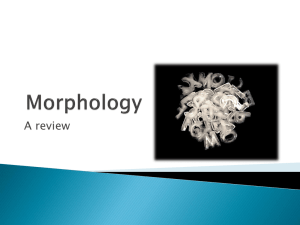Morphology 1 powerpoint presentation
advertisement
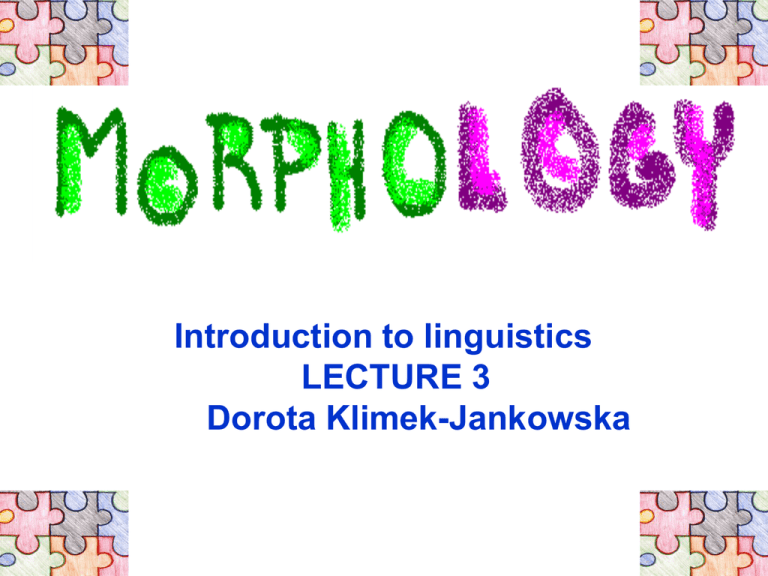
Introduction to linguistics LECTURE 3 Dorota Klimek-Jankowska What is the difference between words in (1) and (2)? (1) (2) cat, replay, lady, comfortable, walk, unnatural, nice, put, rose, cry, love misinterpretations, icecream, bigheaded, sisterhood, Words in (2) can be broken down into still smaller units. How many units does the word unnatural consist of? Does the first unit have a meaning? What does un- mean? The smallest meaningful element of a language is called.... Morphology focuses on these linguistic regularities which are active in our mind and which determine the way we structure of words in natural language. • Now consider the words look, looks, and looked. • Are -s and -ed morphemes? • Do they have any meaning • What role do they play? Morphemes are the smallest units of a language that can be associated with meaning or grammatical function. Exercise1: Look at the following list of words. Try to divide each word into parts. 1. timetable 4. grammarian 7. recreate 2. emptiness 5. personified 8. unfriendly 3. meaningful 6. non-smoker 9. surfer What is the difference between morphemes in (3) and (4) (3) cat, happy, girl, flower (4) un-, re-, -s, -ation, -able, -ed What is the difference between morphemes in (3) and (4) (3) cat, happy, girl, flower FREE MORPHEMES CAN STAND ALONE (4) un-, re-, -s, -ation, -able, -ed BOUND MORPHEMES ARE ALWAYS ATTACHED TO SOME OTHER MORPHEME. Exercise 2: The following words are made up of either one or two morphemes: isolate them and decide for each if it is free or bound a. cats d. broken g. biggest j. entrust b. unhappy e. milder h. childhood k. signpost c. rejoin f. hateful i. greedy l. spacious ROOT: the most essential form of a word that cannot be further analyzed without total loss of identity. It is also that part of the word left when all affixes are removed We can attach AFFIXES to roots. A PREFIX attaches to the beginning (unhappy, impossible, misinterpret) and a SUFFIX attaches to the end of a word (excitement, sisterhood, information). BASE: the form to which an affix is attached. UNHAPPINESS HAPPY – functions as a root and a base UNHAPPY – (prefix ‘un-’ + root ‘happy’) (base ‘unhappy’ + suffix ‘-ness’) UNHAPPINESS Infix – a type of affix which occurs within a base. Morphemes can be devided into: lexical (carry a certain functional morphemes meaning) e.g. verbs, nouns, adjectives, adverbs (purely grammatical function) e.g. articles, conjunctions, numerals, prepositions (5) car, book, sun, doll, dress… (open class) (6) the, on, one, and, or, a (closed class) Exercise 4: Identify a part of speech (lexical category) ADJECTIVE, NOUN, PREPOSITION, ADVERB, VERB 1) slowly, 2) funny, 3) freedom, 4) friendly, 5) pass by, 6) selection, 7) fast, 8) complain, 9) from, 10) single, 11) roses, 12) across, 13) satisfy, 14) satisfactory, 15) memorable, 16) memory, 17) always, 18) above, 19) round, 20) around, 21) kiss, 22) moving, 23) company, 24) hiss, 25) teddy bear BOUND MORPHEMES: INFLECTIONAL DERIVATIONAL Exercise: Identify the function of the following inflectional suffixes Stem wait wait wait eat chair chair fast fast Suffix -s -ed -ing -en -s -'s -er -est Function DERIVATIONAL MORPHEMES • -ship, -hood, -able, -ment, -tion, re-, un-, in-, -al, -ly Change the part of speech e.g., -ment added to a verb forms a noun: judge-ment Change the meaning of a word, re-activate means 'activate again'. Are usually not very productive –hood cannot attach to all members of a class of nouns brother, neighbo but not *friendhood, *daughterhood, or *horsehood. Derivational morphemes occur before inflectional suffixes, e.g., govern-ment-s: -ment, a derivational suffix, precedes -s, an inflectional suffix. Derivational morphemes may be prefixes or suffixes (in English), e.g., pre-arrange, arrange-ment. INFLECTIONAL MORPHEMES -ed, -s, ‘s, -er, -ing, -en, est Inflectional morphemes do not change meaning or part of speech, e.g., dog - dogs are both nouns, jump – jumps - jumped are all verbs. Inflectional morphemes indicate grammatical relations between words John love-s Mary -s marks the 3rd person singular present form of the verb, relating it to the 3rd singular subject John. Inflectional morphemes are very productive. They typically occur with all members of a lexical category the plural morpheme -s occurs with almost all nouns. Inflectional morphemes occur after derivational morphemes e.g., ration-al-iz-ation-s: -s is inflectional, and appears at the very end of the word. (hence they are suffixes only). Exercises 5 -9 on the handout The same morpheme may have more than one phonological manifestation. Different phonological realizations of a morpheme are called allomorphs. QUIZ 1. Which morpheme can stand alone as a word? free or bound 2. Which morpheme has the principal meaning of the word it's in? stem or affix 3. Which morpheme creates a new word by changing the meaning or part of speech, or both? derivational or inflectional • 4. Which morpheme has a meaning or causes a change in meaning when added to a word? content or function morpheme Word formation process DERIVATION/AFFIXATION – adding affixes which changes meaning or category e.g. un-lucky, excite-ment COMPOUNDING – putting two words together in order to create a new lexical item. Compounds consist of more than one stem street light, happy hour, bookcase, blackird, overload, fireman, forget-me-not CLIPPING – (abbreviations) - the word-formation process in which a portion of a longer word is used to produce a clipped word. • telephone – phone • refridgerator – fridge • exam(ination) • math(ematic), • lab(oratory) BLENDING – mixing words together, a blend is a word formed from parts of two other words • brunch = breakfast + lunch • motel = motor + hotel • smog = smoke + fog BACKFORMATION – the reverse of affixation, creation of a new word from an existing word falsely assumed to be its derivative. For example, the verb ‘to edit’ has been formed from the noun ‘editor’, donation from ‘to donate’. CONVERSION: changing a category (a part of speech) without changing a form • a bottle – to bottle • butter – to butter • a drink – to drink ACRONIMIZATION – letter abbreviations: NATO, ZUS, PZU, BBC SUPPLETION: a root morpheme is replaced by a phonologically unrelated form go – went 1.REDUPLICATION: duplicates all or part of the base Indonesian: anak – child, anak anak – children Turkish: gyzel – beautiful, gyzel gyzel – very beautiful CRANBERRY MORPEMES: determining its internal structure is tricky since berry is clearly a morpheme, we do not know what to make of cran- which never occurs elsewhere in language as an independent bound morpheme. THANK YOU

